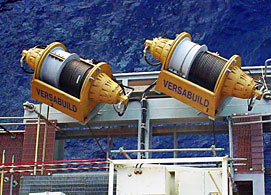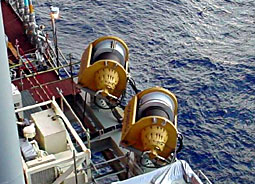Lantec Winch Comes Through in the Pinch
|

This overhead view of Versabuild's twin-winch arrangement shows the
winches perched at the side of the offshore platform above the Gulf
waters. Wire rope descends from the winches to steer the risers laterally
with precise positioning. Drive motors on both ends of the winches provide
the muscle to generate 50 tons of lift from each winch. |
An offshore oil platform is no place to take chances with machinery,
especially when it's sitting in the middle of the ocean. Between the rough
weather, the long travel distance, and the huge costs of downtime, only the best
equipment can be trusted to work on time, every time in the offshore world.
Allied's Lantec planetary winch proved its mettle on a recent project in the
Gulf of Mexico.
Versabuild LLC, an offshore equipment and heavy lift specialist in Belle
Chasse, Louisiana, recently had a challenging assignment for Shell's Nakika
platform, which sits about 150 miles off the US coast in the Gulf of Mexico.
This platform is connected to subsea wells about two miles away by several
submersed pipelines. The pipelines are linked to the platform by steel catenary
risers. The installation of the platform risers requires the simultaneous
vertical lifting and lateral steering to position the top of the risers into
their respective hang-off porches. For the Nakika platform the very high weights
of the risers required the use of a hydraulic chain jack to provide the lift.
To steer the pipe laterally, Versabuild placed two Lantec planetary winches
side-by-side on the platform. Each winch was outfitted with 500 feet of
1-1/4-inch EEIP wire rope. The winch lines were fleeted through underwater
snatch blocks located on the hull pontoons and connected to rigging on the riser
pull head. An ROV (remotely operated vehicle) with camera allowed the winch
operator to observe the pipe position at the pull head. The operator adjusted
the cable positions on the two winches to maneuver the pipe into position, which
had to be accurate to within about 1 inch. As the riser was pulled up, the
winches reeled in wire rope to maintain the pipe position.
The winches did not need high line speed, but did need to provide load and
displacement control. A minimum line pull of 50 tons was required for each
winch. Allied's engineers worked closely with their counterparts at Versabuild
to refine a standard winch design with a twist—put on two sets of motors and
drives to power one drum. The dual-drive winch uses the same drum as a standard
single-drive winch, but has a complete set of reduction gears and hydraulic
drive motor on each side of the drum. This doubles the torque supplied to the
drum, which doubles the line pull over a single-drive model. This dual-drive
Lantec 750 winch was able to generate over 50 tons of line pull.
Versabuild designed and built the complete power package and winch mounting
arrangement. The HPU was driven by a Caterpillar 185 HP diesel engine. It
produces hydraulic power of 75 gpm at 2500 psi. The flow was split between the
two winches, and was more than adequate to provide the power needed.
(Continued from previous page)
The winch mounting was creative. Versabuild needed to handle the installation
of several risers without relocating the winches and HPU multiple times. The
solution was to mount each winch on a rotating pedestal that could be locked
into place with a locking pin. To steer a different riser, the winches could be
rotated to the most favorable angle quickly.
The winches were initially on the platform for about eight months, and then
returned to shore. They will soon go back to the Shell Nakika for another two to
three months of hard duty.
Project Manager Jason Fabre of Versabuild reports that "the winches worked
perfectly. We had some other small problems, but none at all with winches."
Tough job. Tough winch. Problem solved.
|

The Allied Lantec 750 winches sit on a center pivot so that they can be
rotated to connect to one of several incoming risers. The Cat-powered 185
HP hydraulic power unit is at the left. |

